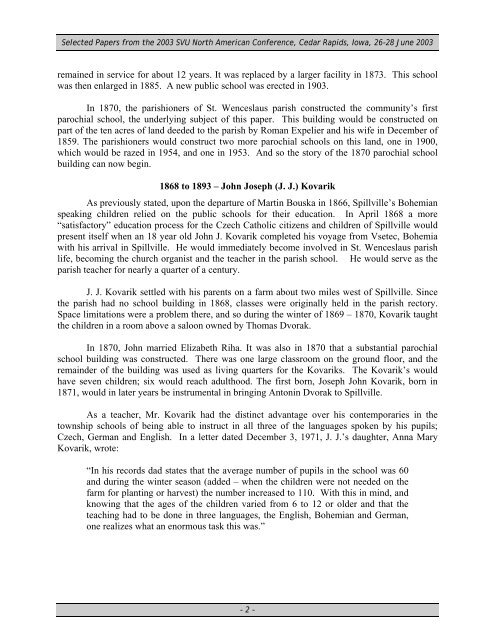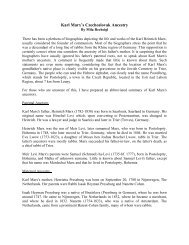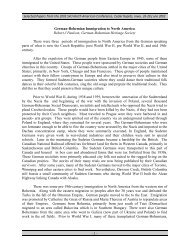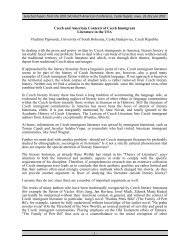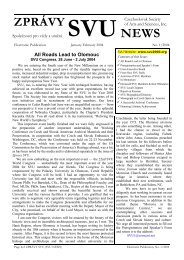Oh, if only these walls could speak - Czechoslovak Society of Arts ...
Oh, if only these walls could speak - Czechoslovak Society of Arts ...
Oh, if only these walls could speak - Czechoslovak Society of Arts ...
Create successful ePaper yourself
Turn your PDF publications into a flip-book with our unique Google optimized e-Paper software.
Selected Papers from the 2003 SVU North American Conference, Cedar Rapids, Iowa, 26-28 June 2003<br />
remained in service for about 12 years. It was replaced by a larger facility in 1873. This school<br />
was then enlarged in 1885. A new public school was erected in 1903.<br />
In 1870, the parishioners <strong>of</strong> St. Wenceslaus parish constructed the community’s first<br />
parochial school, the underlying subject <strong>of</strong> this paper. This building would be constructed on<br />
part <strong>of</strong> the ten acres <strong>of</strong> land deeded to the parish by Roman Expelier and his w<strong>if</strong>e in December <strong>of</strong><br />
1859. The parishioners would construct two more parochial schools on this land, one in 1900,<br />
which would be razed in 1954, and one in 1953. And so the story <strong>of</strong> the 1870 parochial school<br />
building can now begin.<br />
1868 to 1893 – John Joseph (J. J.) Kovarik<br />
As previously stated, upon the departure <strong>of</strong> Martin Bouska in 1866, Spillville’s Bohemian<br />
<strong>speak</strong>ing children relied on the public schools for their education. In April 1868 a more<br />
“satisfactory” education process for the Czech Catholic citizens and children <strong>of</strong> Spillville would<br />
present itself when an 18 year old John J. Kovarik completed his voyage from Vsetec, Bohemia<br />
with his arrival in Spillville. He would immediately become involved in St. Wenceslaus parish<br />
l<strong>if</strong>e, becoming the church organist and the teacher in the parish school. He would serve as the<br />
parish teacher for nearly a quarter <strong>of</strong> a century.<br />
J. J. Kovarik settled with his parents on a farm about two miles west <strong>of</strong> Spillville. Since<br />
the parish had no school building in 1868, classes were originally held in the parish rectory.<br />
Space limitations were a problem there, and so during the winter <strong>of</strong> 1869 – 1870, Kovarik taught<br />
the children in a room above a saloon owned by Thomas Dvorak.<br />
In 1870, John married Elizabeth Riha. It was also in 1870 that a substantial parochial<br />
school building was constructed. There was one large classroom on the ground floor, and the<br />
remainder <strong>of</strong> the building was used as living quarters for the Kovariks. The Kovarik’s would<br />
have seven children; six would reach adulthood. The first born, Joseph John Kovarik, born in<br />
1871, would in later years be instrumental in bringing Antonin Dvorak to Spillville.<br />
As a teacher, Mr. Kovarik had the distinct advantage over his contemporaries in the<br />
township schools <strong>of</strong> being able to instruct in all three <strong>of</strong> the languages spoken by his pupils;<br />
Czech, German and English. In a letter dated December 3, 1971, J. J.’s daughter, Anna Mary<br />
Kovarik, wrote:<br />
“In his records dad states that the average number <strong>of</strong> pupils in the school was 60<br />
and during the winter season (added – when the children were not needed on the<br />
farm for planting or harvest) the number increased to 110. With this in mind, and<br />
knowing that the ages <strong>of</strong> the children varied from 6 to 12 or older and that the<br />
teaching had to be done in three languages, the English, Bohemian and German,<br />
one realizes what an enormous task this was.”<br />
- 2 -


